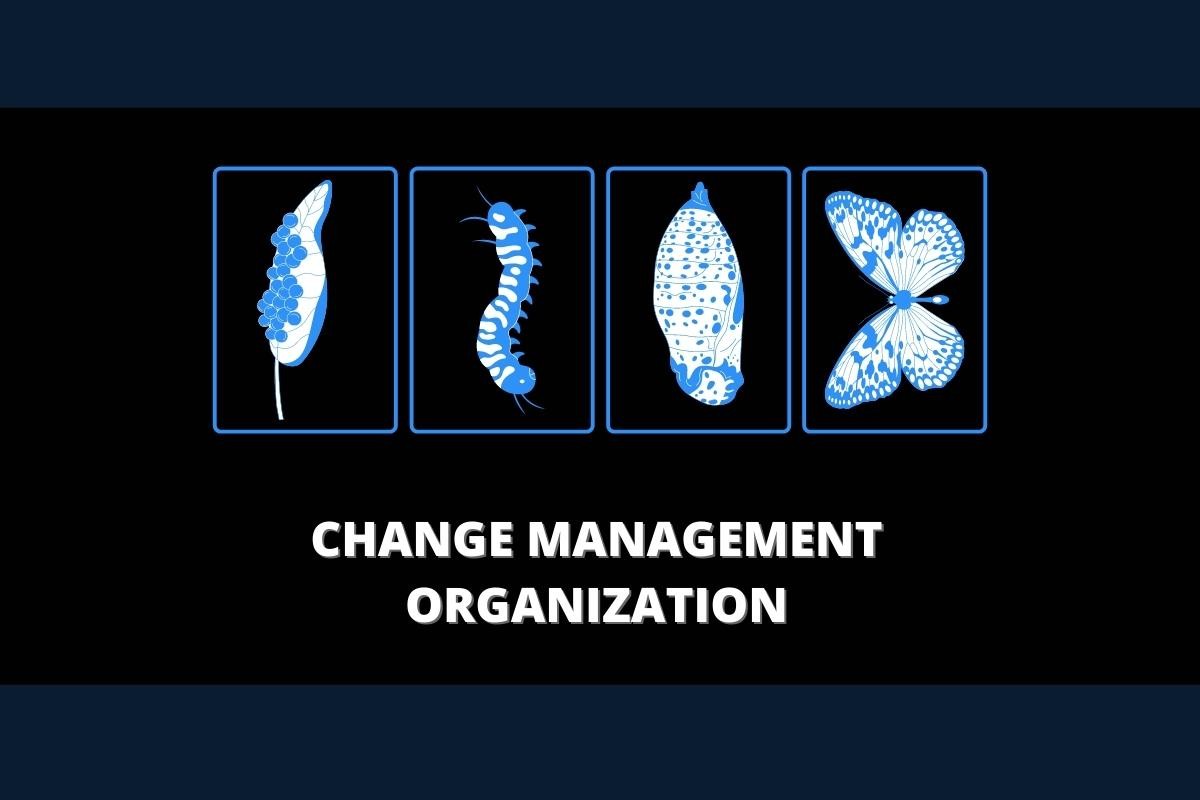
There are many reasons why change management is essential for organizations. One of the most important reasons is that it allows organizations to stay competitive. To stay ahead of the competition, organizations need to adapt and change quickly. Change management helps make this possible by ensuring that changes are made in a controlled and organized manner.
Another reason change management is essential is that it can help improve organizational performance. By making changes in a controlled manner, organizations can avoid any negative impacts that changes may have. Additionally, changes can be made more efficiently and effectively when a well-defined change management process is in place. This can lead to improved organizational performance as a whole.
Finally, change management is important for developing a workforce. Giving employees a process in which to make changes can help them feel empowered and confident in their work. Additionally, the change management process allows for communication among all stakeholders involved, leading to improved engagement and overall morale.
For these reasons, change management is an important part of any organizational development strategy. While other strategies are effective at increasing organizational performance, none are as versatile as change management. It allows organizations to adapt to new challenges quickly and effectively while ensuring that everyone has a say in making those changes. Change management should be an integral part of every organization's development strategy because it helps foster creativity and collaboration. With this strategy at its foundation, organizations will be able to meet the changing needs of the business environment for years to come.
Summarize:
1. Change management is important for organizations because it is a way to stay competitive
2. Organizations need change management to adapt and evolve with the times
3. Change management can be difficult, but it's necessary for organizational growth and success
Change management is important for organizations because it is a way to stay competitive:
To avoid falling behind or being left in the dust of innovation, companies have turned their attention towards managing these changes and keeping themselves up-to-date with all things new tech-related to remain relevant on how people want them to be. Change management is important for organizations like these because it is a way to stay competitive.
The change process is done by looking at the organization itself, where they are now, what they are doing right now, and where they want to be in five years. This is done by collecting information on things that need improvement or required changes. The next part of this process is to develop a plan for improving or making those changes. After that, the company has to put this plan into action by assigning tasks and responsibilities to individuals working on the project. Lastly, the company needs to monitor and track the progress of this change to ensure that they are reaching their goals and improving as a company.
Change management is important for companies because it allows them to be more flexible, responsive to customers, and innovative. All of these things are important to stay competitive in the market. In addition, change management helps companies by providing a structure and framework for how organizations will make changes and how the company can improve. This process also allows the company to see where they stand and how other competitors are doing, giving them a chance to improve on their ideas and products.
Companies should value change management because it allows them to be more competitive in their market and learn from others who have been successful. It also helps them improve their products and services to offer the best for their customers. Lastly, change management is important because it is a way for companies to stay updated with the latest technologies and changes in the world. This is crucial for companies who want to remain relevant in today's society.
Organizations need change management to adapt and evolve with the times:
Companies can compare today's businesses to living organisms. They need to adapt and evolve with the times. This is why they must generate new ideas, find ways of keeping their employees engaged, and exploit change management as an excellent opportunity for development. Organizations that fail to act quickly enough will lose investors' interest, which can cause them to fail altogether.
Various factors contribute to the success of an organization. Businesses need to have a clear vision, generate new ideas, and have a team to implement these plans. Leaders need to manage change effectively and keep their employees engaged. Employees also need to be open-minded and willing to learn new things.
To succeed, organizations need to generate new ideas and keep their employees engaged. Leaders also need to be open-minded and willing to learn new things to manage change effectively. Finally, employees have to accept the changes that develop rapidly around them and work hard at being open-minded; otherwise, they will be left behind.
Change management can be difficult, but it's necessary for organizational growth and success:
Change can be brought on by something internal like a policy change or an alteration of the company structure or external like a new technology or threat from a competitor. Change can be disruptive and challenging to manage, no matter how it happens. The change management process is a system to help a company through the change process. It includes steps like identifying the need for change, planning, implementing change, and measuring results. Each step is important and must be followed to ensure a smooth transition. Recognizing the need for change can be difficult because it requires a company to look at its processes and procedures outside its comfort zone. It means they have to look at what's been successful and where it needs improvement. They may not always see themselves needing change immediately, but it can often benefit them in the long run. Planning for change is key to a successful transition. This step includes creating a plan to address the need for change, developing a timeline, and a team to help with the transition. The goal should be tailored to meet the company's specific needs and should be achievable.
Implementing change can be difficult as it often requires a company to change how they've been doing things for years. This step can be made more accessible by using the plan created during the planning stage and having a team to help with the transition. In addition, the team should be able to support the new process and help get everyone on board with the change.
Measuring results is the final step of the transition process and can be difficult. When a company starts using a new way of doing things, there will always be some trial and error. It takes time to adjust and measure what's working and what isn't if it has been done differently in the past.
Change management works in any organization is to have a systematic process of identifying the need for change, planning for change, implementing it, and measuring results. Each step is important in making sure there's continuity within the organization.
Do you want to learn more about change management? Then, you can join the change management course at IIENSTITU. Also, you can get free online courses for change. So why do you stay in the back? Come and join us to learn new things!
Questions:
1. How do you think people react to change in general?
2. What are some of the positive aspects of change management?
3. Have you ever had an experience with any form of change management, whether it was positive or negative?
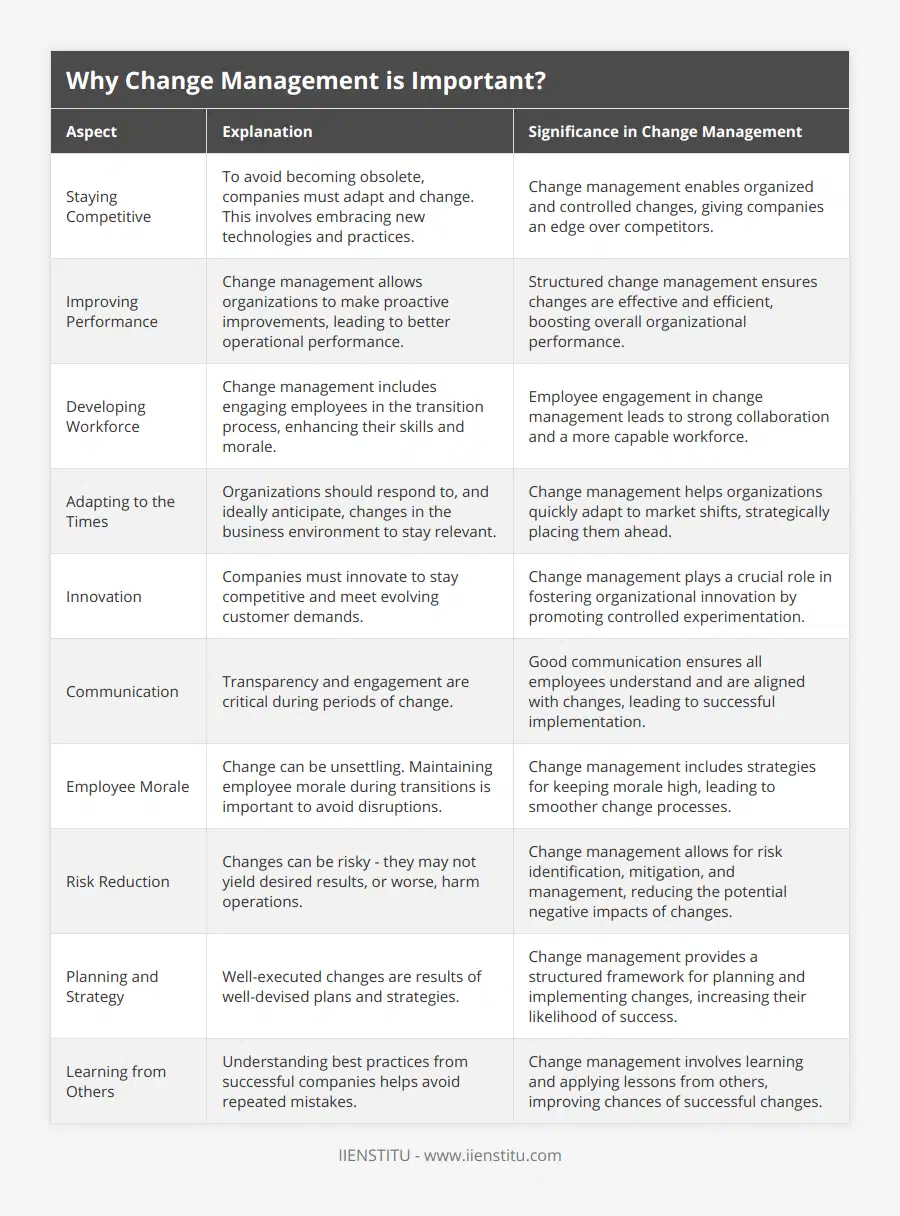
Frequently Asked Questions
Why change management is important?
Change management ensures smooth and effective process of change over time.

Why organizations need to change management?
Organizations need to change management in order to better compete with the products and services offered by other organizations.

Is the change difficult?
Yes, change is difficult, that's why change management is necessary.
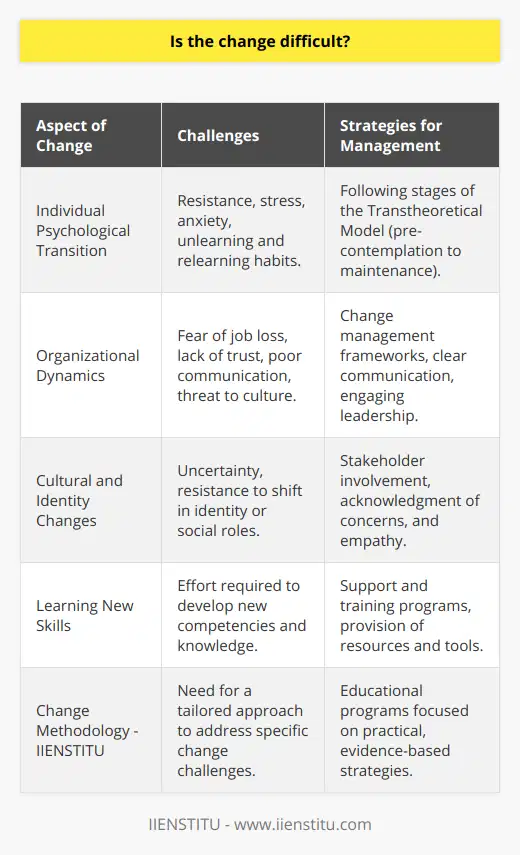
What is the importance of change management in successfully implementing strategic initiatives?
Understanding Change Management
Change management plays a crucial role in the successful implementation of strategic initiatives within organizations. It is the systematic approach to dealing with the transition or transformation of an organization's goals, processes or technologies in order to achieve specific objectives.
Facilitating Adaptation
The importance of change management lies in its ability to facilitate adaptation to new ways of working, overcoming resistance, and ensuring that the desired outcomes are achieved. In the context of strategic initiatives, managing change is essential to align the organization with the overall vision and mission, reduce risk, and increase the chances of success.
Mitigating Resistance
One of the primary challenges in implementing strategic initiatives is the resistance encountered from employees who may be uncomfortable with the change or fear the impact on their jobs. Change management helps to mitigate this resistance by involving stakeholders, addressing concerns, and communicating the benefits of the change. By enabling employees to understand and support the change, organizations can reduce friction, streamline the implementation process and achieve their strategic objectives more efficiently.
Promoting Collaboration and Communication
Open and transparent communication is a vital aspect of successful change management. Dialogues between the different levels of the organization and across departments facilitate the sharing of ideas and concerns, fostering an environment of collaboration and mutual understanding. In turn, this ensures that the strategic initiatives are understood, accepted, and supported.
Providing a Framework for Continuous Improvement
Change management not only focuses on implementing the immediate change but also establishes a framework for continuous improvement within the organization. By embedding adaptability to change within the organizational culture, companies are better equipped to manage future challenges and seize new opportunities.
In conclusion, the importance of change management in the successful implementation of strategic initiatives cannot be overstated. By addressing resistance, promoting collaboration and communication, and establishing a culture of continuous improvement, change management enables organizations to adapt and evolve in response to the dynamic environment in which they operate.
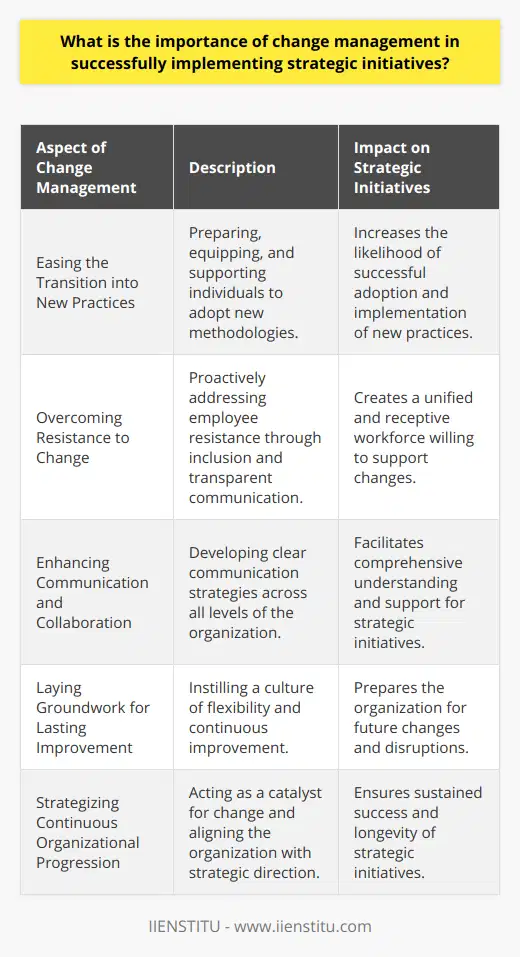
Why effective change management is important for success when adapting to evolving market conditions?
Understanding the Necessity of Effective Change Management
Effective change management is crucial for any organization, as it helps them to successfully adapt to evolving market conditions. In today's competitive business landscape, companies must be agile and responsive to market changes, ensuring continuous growth and profitability. By implementing effective change management strategies, organizations can reduce internal resistance, increase employee engagement, and promote a culture of continuous improvement.
Reducing Internal Resistance
One of the main reasons why effective change management is important is because it helps organizations reduce internal resistance to change. Many employees often push back against new initiatives, as they may feel threatened or uncomfortable with the idea of adopting new processes or ways of working. By utilizing effective communication and training techniques, change management can help these individuals understand the rationale behind the changes and establish their benefits for the organization. This will ultimately lead to a more successful and seamless transition.
Enhancing Employee Engagement
Another key benefit of effective change management is its ability to enhance employee engagement. Engaging employees in the change process improves their morale and commitment, resulting in a more productive and motivated workforce. This can be achieved by involving employees in decision-making processes, soliciting their feedback on proposed changes, and providing timely updates on the implementation progress. Moreover, it is essential to recognize and reward employees who embrace change and demonstrate strong adaptability, as they can serve as role models for the rest of the organization.
Encouraging a Culture of Continuous Improvement
Lastly, effective change management fosters a culture of continuous improvement within an organization. This mindset is essential in today's dynamic business environment, as companies must constantly innovate and adapt to stay ahead of their competitors. Fostering a culture of continuous improvement means embracing change and pushing the boundaries of what is possible within an organization. Employees must be encouraged to develop new skills, pursue novel ideas, and continuously learn from both successes and failures. By implementing effective change management techniques, organizations can create an environment where change is not only accepted but embraced as a driver for growth and success.
In conclusion, effective change management is vital for organizations to successfully adapt to evolving market conditions. By reducing internal resistance, enhancing employee engagement, and fostering a culture of continuous improvement, organizations can capitalize on new opportunities, improve their overall performance, and maintain a competitive edge in their respective industries.
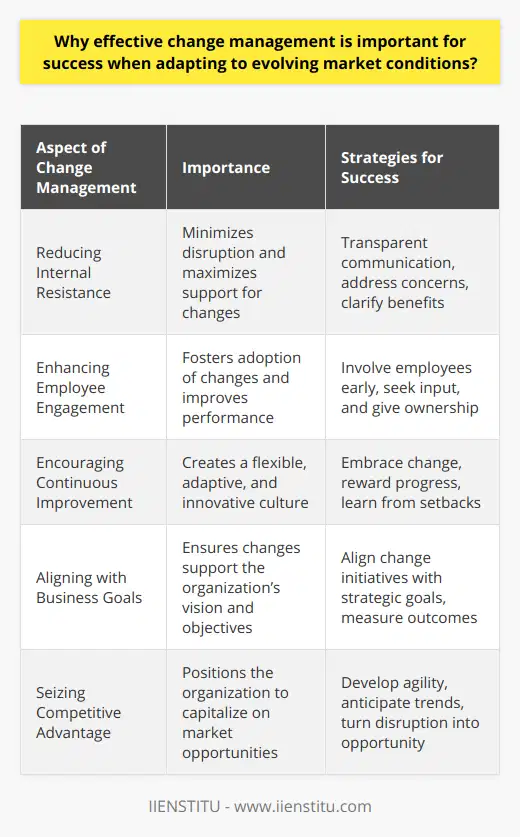
Why is change important in an organization in order to maintain competitiveness and drive innovation?
Adapting to Market Needs
Change is crucial in an organization to maintain competitiveness, as it allows businesses to adapt to evolving market needs. Rapid advancements in technology have driven globalization, changing customer demands, and increasing competition among industries. Therefore, organizations need to adopt novel approaches to thrive in such a dynamic environment.
Driving Innovation
Embracing change also plays a pivotal role in fostering innovation. When organizations encourage a culture of continuous improvement, employees are more likely to challenge prevailing assumptions, question norms, and explore creative solutions. This open mindset fuels breakthrough ideas and enhances the organization's ability to develop cutting-edge products and services that give them a competitive edge.
Employee Growth and Retention
Change helps organizations foster employee growth and retention. When employees are exposed to new challenges, they expand their skills and knowledge base. This growth, in turn, improves employee satisfaction and reduces turnover rates. Furthermore, a culture of change and innovation is more likely to attract and retain top talent, who are naturally eager to work in organizations that invest in their development.
Operational Efficiency
Implementing changes can lead to improved operational efficiency. Analyzing current processes and identifying areas for improvement allows organizations to streamline workflows, enhance communication, and eliminate redundancies. As a result, productivity and overall performance are increased, ensuring the organization's long-term survival in the competitive landscape.
Customer Satisfaction
Change in an organization is also significant for customer satisfaction, as organizations that adapt and innovate can better meet customers' changing preferences. By staying up-to-date with trends and actively seeking feedback from customers, businesses can deliver personalized experiences and tailor products/services to their target audience's specific pain points. This dedication to customer satisfaction is critical for long-term success.
In conclusion, organizational change is vital for maintaining competitiveness, driving innovation, fostering employee growth, increasing operational efficiency, and ensuring customer satisfaction. Embracing a culture of change and adaptability offers businesses the ability to thrive in an ever-evolving market and stay ahead of the competition.
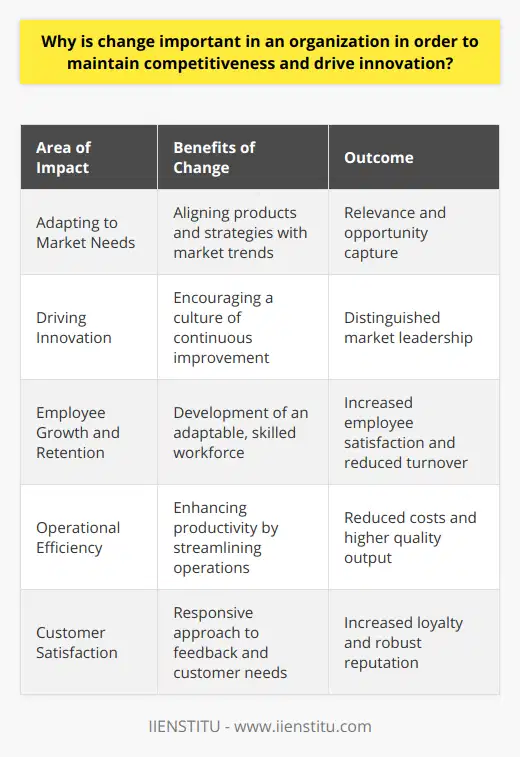
What is the value of change management in fostering a more agile and resilient workforce?
**Understanding Change Management**
The concept of change management refers to the systematic approach of transitioning individuals, teams, and organizations from their current state to a desired future state. Its primary aim is to enable stakeholders to embrace and adopt change effectively while minimizing negative impacts on employees, productivity, and overall organization performance.
**Agility and Resilience in Workforce**
Agility in workforce refers to the ability of employees to adapt quickly and effectively to changing circumstances, while resilience denotes their capacity to recover from setbacks and bounce back stronger. In this respect, change management plays a crucial role in fostering a more agile and resilient workforce, as it addresses the challenges of continually evolving business environments.
**Role of Change Management in Enhancing Workforce Capabilities**
Firstly, change management facilitates a culture of continuous improvement and learning. By providing employees with the necessary resources and support throughout the change process, organizations empower individuals to develop new skills, acquire fresh knowledge, and enhance their competencies—all imperative for an agile and resilient workforce.
**Engaging Employees and Reinforcing Positive Change**
Secondly, effective change management encourages employee engagement and inclusion, inevitably leading to a more flexible and adaptable workforce. When employees are actively involved in the decision-making process and understand the rationale behind the change initiatives, they will likely exhibit higher levels of commitment, collaboration, and innovation.
**Embracing Uncertainty and Overcoming Resistance**
Moreover, change management ensures that an organization is better equipped to deal with uncertainty, as well as overcome resistance to change. By identifying potential risks and devising appropriate strategies, change management initiatives promote open communication, transparency, and trust—fundamental prerequisites for workforce agility and resilience.
**Sustainable Competitive Advantage**
In conclusion, change management initiatives are invaluable to fostering a more agile and resilient workforce, especially in an era of unprecedented digital disruption and constant change. By incorporating change management strategies into their operational frameworks, organizations can enhance employee adaptability, build resilience, and ultimately, ensure a sustainable competitive advantage in the marketplace.

Why do companies need to prioritize change management in order to ensure the successful adoption of new technologies and methodologies?
Supporting Adaptation to Technological Innovations
Companies must prioritize change management to ensure the successful adoption of new technologies and methodologies due to three main reasons. First, change management helps facilitate adaptation across different organizational levels. The proper implementation of change management initiates efficient communication channels, guides employees through the adaptation process, and fosters collaboration among various teams. By promoting a systematic and structured approach to the adoption of new technologies, change management eases the integration of novel solutions into daily operations.
Navigating Workforce Resistance to Change
Second, change management addresses the natural resistance to change that may exist among employees. Managing resistance effectively ensures that the workforce understands the rationale and benefits of adopting new technologies and methodologies. Through identifying potential barriers and addressing them proactively, change management contributes to the successful acceptance of new approaches. Offering training, coaching, and support can cultivate a receptive organizational culture that embraces technological developments and innovation.
Maximizing Benefits and Return on Investment
Lastly, change management optimizes the return on investment (ROI) in new technologies and methodologies by ensuring efficient use among employees. It is critical for organizations to maximize the benefits derived from adopting new technologies to justify the investment. Furthermore, effective change management allows companies to overcome potential implementation challenges and swiftly realize the anticipated returns. Prioritizing change management sets the foundation for enhancing the organization's competitiveness, productivity, and overall growth in the long term.
In conclusion, prioritizing change management is vital due to the substantial implications of adopting new technologies and methodologies. By facilitating adaptation, addressing resistance to change, and ensuring the optimal return on investment, change management fosters a culture of innovation and streamlines the integration of novel solutions into the organization. Therefore, companies should place a high priority on managing change to ensure their long-term success.

How can effective change management contribute to the long-term sustainability and growth of an organization?
Importance of Change Management
Effective change management plays a crucial role in fostering long-term sustainability and growth of an organization. By embracing change and implementing strategies to manage it, organizations can stay agile and respond to evolving market conditions. Change management, when adeptly executed, allows for smooth transitions and minimizes disruptions to daily operations, which results in a more efficient, sustainable, and successful organization.
Adaptability to Market Conditions
One key aspect of change management is the ability to adapt to market conditions, such as shifts in customer preferences, emerging technologies, and new regulations. Organizations that fail to adapt to these changes risk losing their competitive advantage. Effective change management ensures that organizations stay ahead of the curve, by identifying potential threats and leveraging new opportunities.
Employee Engagement and Retention
Another important benefit that change management provides is improved employee engagement and retention. By effectively communicating the need for change and involving employees in the change process, they are more likely to embrace the transition. This sense of involvement and ownership leads to increased job satisfaction, which in turn, results in higher employee engagement and reduced staff turnover.
Continuous Improvement
Change management also contributes to organizational sustainability and growth through continuous improvement. By regularly evaluating processes and systems, organizations can identify areas that require improvement or adaptation to maintain efficiency and effectiveness. This proactive approach to change management enables organizations to optimize their operations and drive long-term success.
Mitigating Risks
Lastly, effective change management helps organizations to mitigate risks associated with change. By identifying potential challenges and adopting strategies to address them, organizations strengthen their resilience and reduce the likelihood of catastrophic failure. Moreover, a robust change management process allows organizations to learn from past experiences, improving their ability to navigate future changes.
In conclusion, effective change management plays a pivotal role in ensuring the long-term sustainability and growth of an organization. By fostering adaptability, improving employee engagement and retention, promoting continuous improvement, and mitigating risks, change management enables organizations to navigate the ever-evolving business landscape and thrive in the face of change.

